Art & Exhibitions
Artists to Watch This Month: 10 Solo Gallery Exhibitions in New York to Have on Your Radar in November
Pipilotti Rist, Raqib Shaw, Jessie Makinson, Shilpa Gupta, and more.
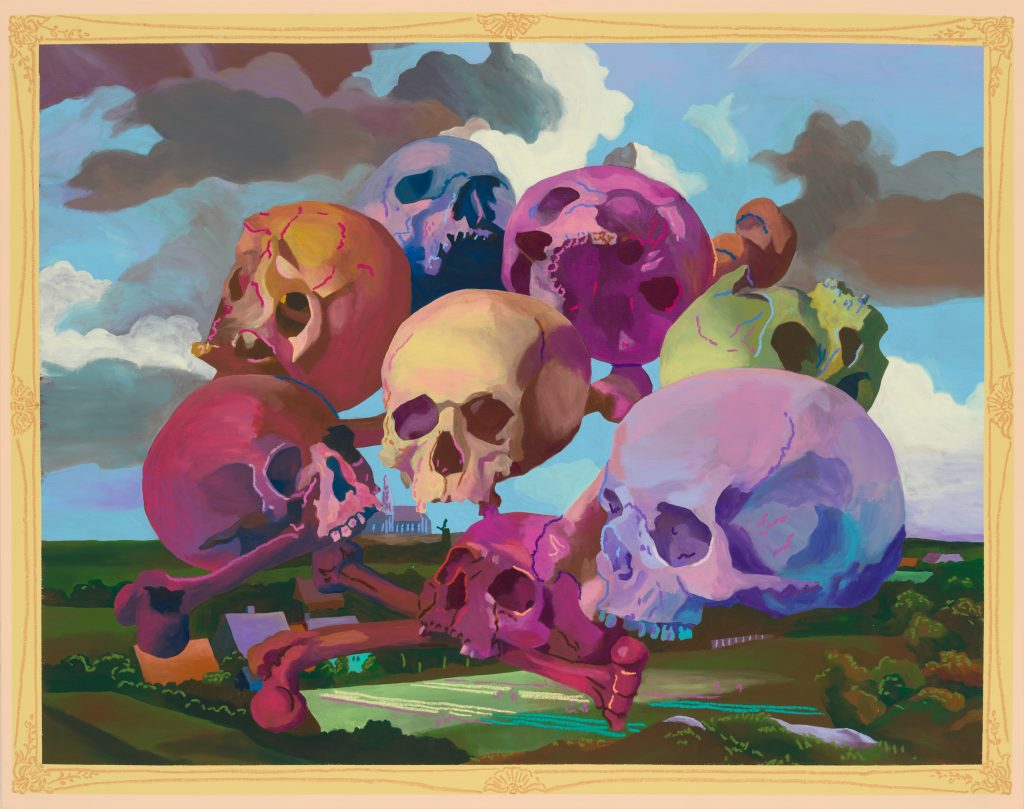
Pipilotti Rist, Raqib Shaw, Jessie Makinson, Shilpa Gupta, and more.

Annikka Olsen

Though the approach of Daylight Savings might mean dark days, galleries are lighting up New York with a torrent of new shows this month. Parsing through the hundreds of exhibitions that have recently—or are soon to be—opened, we’ve rounded up 10 artists taking the spotlight this month in solo shows across the city.
From an artist who uses their practice as a research vehicle to explore the profound implications of biomedical technology to a painter who uses fabric as their primary material, these 10 artists are expanding what their mediums are capable of and the scope of artistic inquiry.
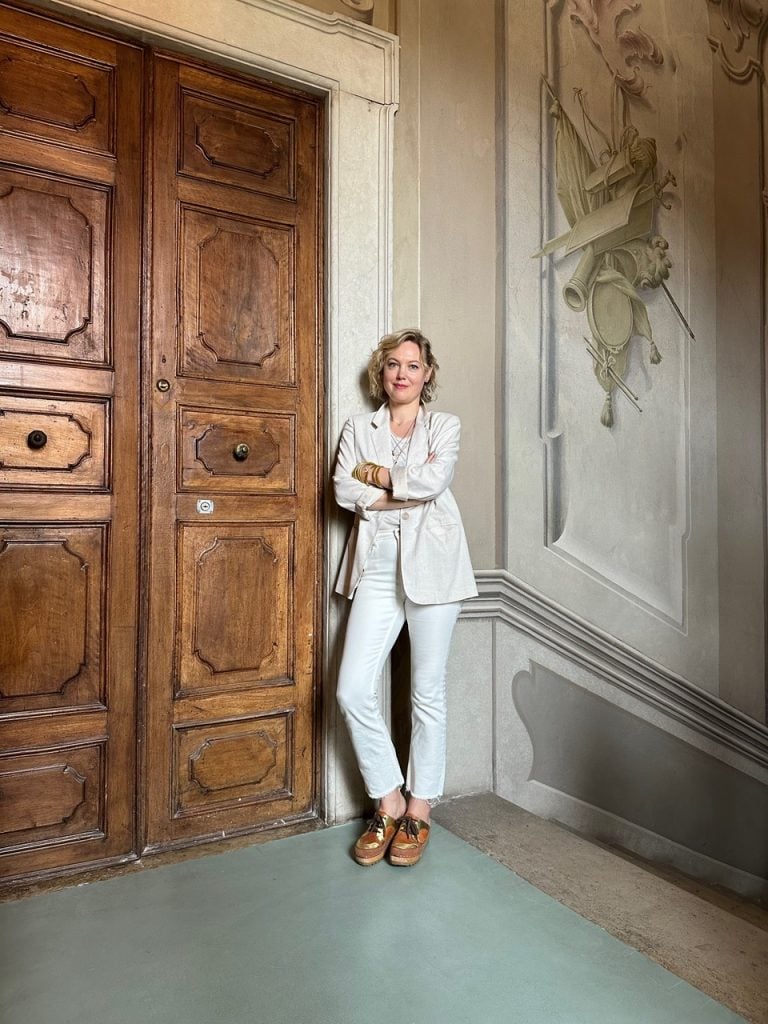
Kirsten Deirup. Photo: Pietro Gatto. Courtesy of the artist and Hesse Flatow, New York.
For her second solo show with Hesse Flatow, Hudson Valley-based artist Kirsten Deirup presents a series of paintings and works on paper in “Ex Voto In Silico.” The title of the show is a play on Latin, with the term “voto” meaning votive or offering, and the term “in silico” an invented Latin term referring to when an object has been put through a computer program. Echoing 20th-century discussions around the essence of art in the face of mechanical reproduction, Deirup’s work confronts the boundary between creation by human hand and artificial intelligence.
Incongruities abound in each composition; plants blossom into dazzling gems, a tree is hung with tennis balls instead of fruit, and plastic spray bottles, a slice of bread, or a computer keyboard appear in otherwise classical-inspired settings. Backgrounds are obfuscated and pervasive shadows lend the otherwise aesthetically pristine vignettes a deep, unshakable sense of the uncanny. Here, the idea of artificial intelligence as it is understood in the realm of art is turned on its head, and Deirup captures the zeitgeist of today as we face the unknown.
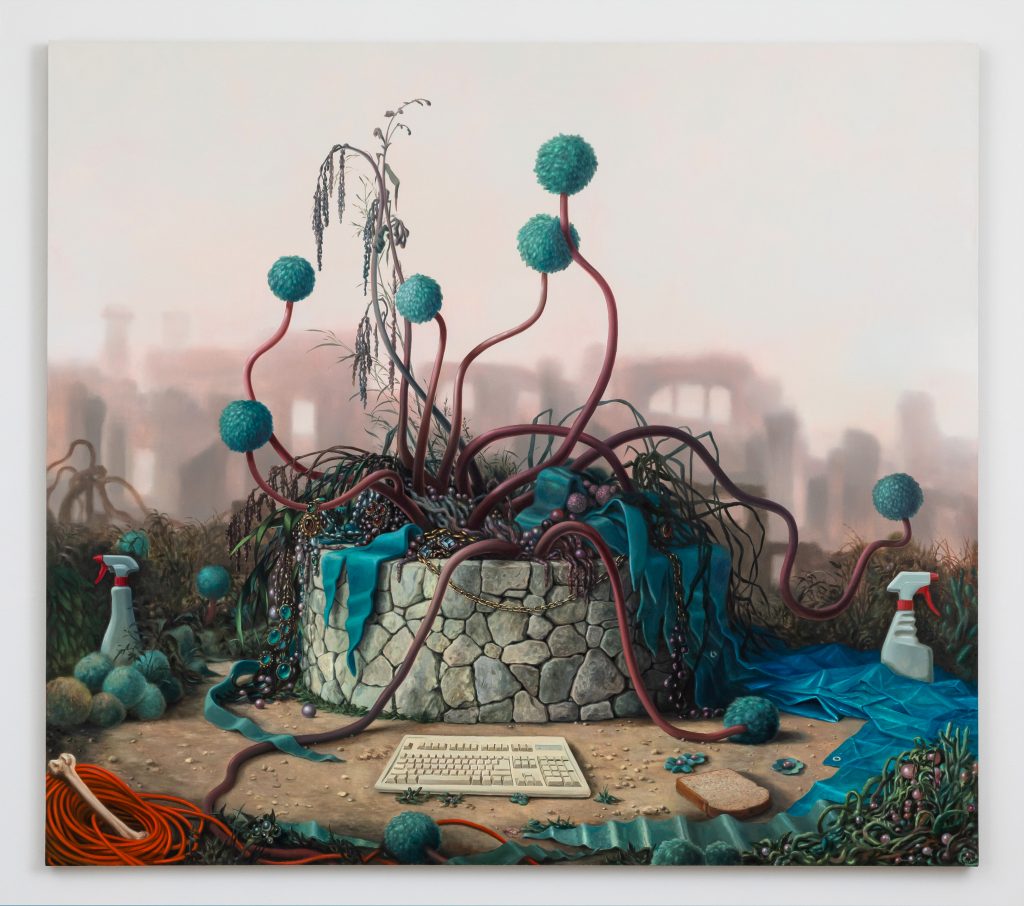
Kirsten Deirup, Ex Voto In Silico (2023). Photo: Jenny Gorman. Courtesy of the artist and Hesse Flatow, New York.
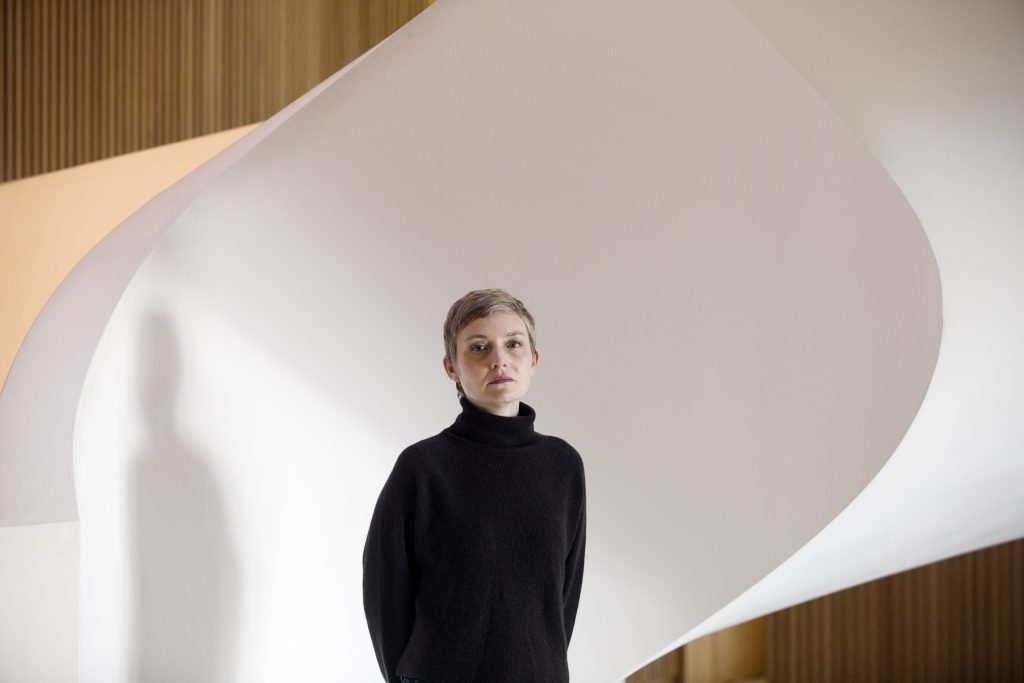
Heather Dewey-Hagborg. Ana Brígida for The New York Times. Courtesy of the artist and Fridman Gallery, New York.
The first genetically engineered pig heart transplant occurred in January of 2022 following decades of research and experimentation. The relationship between pigs and humans, spanning some 10 millennia from their first domestication, lays at the core of artist Dr. Heather Dewey-Hagborg’s newest exhibition, “Hybrid: an Interspecies Opera,” her third solo with Fridman Gallery. Featuring sculptural works, animations, and a film narrated by the artist and set to an original score by composer Bethany Barrett, questions around our very existence—down to our DNA—are explored within the scope of humanity’s long-standing relationship with pigs.
Dr. Heather Dewey-Hagborg received her Ph.D. in electronic arts from the Rensselaer Polytechnic Institute in Troy, New York, is an affiliate of Data and Society and a founding board member of the European Research Council-funded project Digital DNA that explores the relationships between new technologies, DNA, and empirical evidence. Combining expertise with creative expression, Dewey-Hagborg offers a cogent look at the wide-ranging implications of interspecies relationships and new technologies.
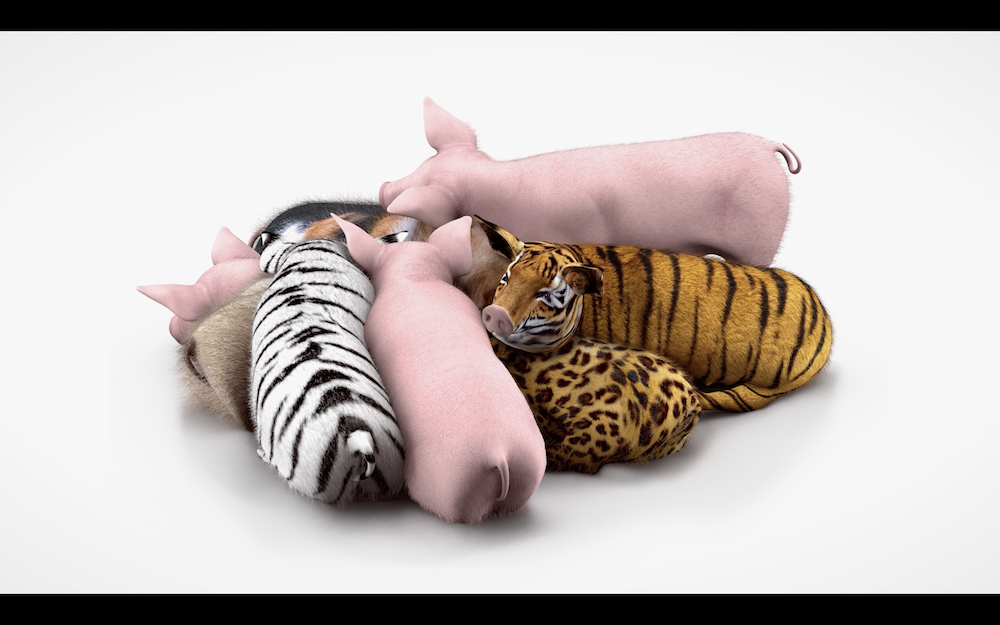
Heather Dewey-Hagborg, film still from Future Pigs, Plural (2022). Courtesy of the artist and Fridman Gallery, New York.
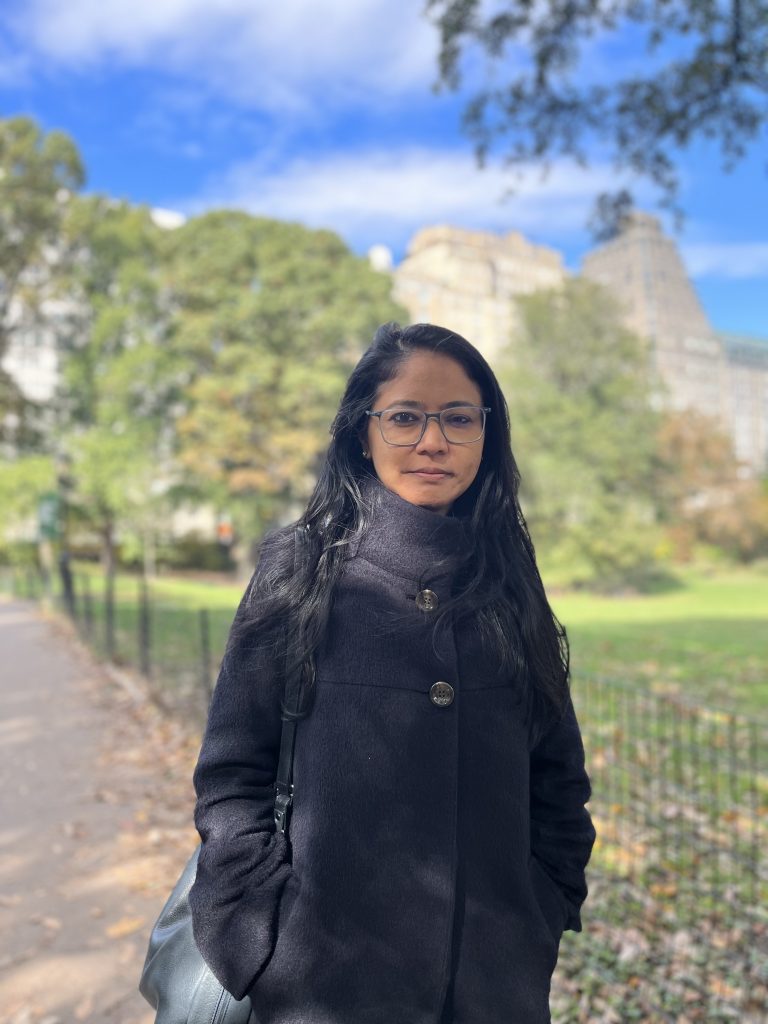
Shilpa Gupta. Courtesy of the artist and Tanya Bonakdar Gallery, New York / Los Angeles.
For her debut self-titled solo exhibition with Tanya Bonakdar Gallery, Mumbai-based artist Shilpa Gupta continues her interrogations of language, cultural identity, and ideas around otherness and power—and its myriad effects and consequences. Paring down both ideas and means to their most essential, Gupta poetically captures the collective essence of experience, transcending time and place.
A new sound installation, Listening Air (2023), is a central work in the exhibition. Shown in a darkened gallery space, suspended microphones counterbalanced by dimmed light fixtures move through the air. Rather than take sound, however, the microphones have been turned into speakers which emit spoken words. Leveraging the power of language as a form of resilience and resistance, the work is both haunting and beautiful, a testament to the pervasive desire to speak and be heard.
Concurrent to the present exhibition, Gupta is the subject of a solo exhibition curated by Ruth Estévez at Amant, Brooklyn, on view through April 28, 2024.
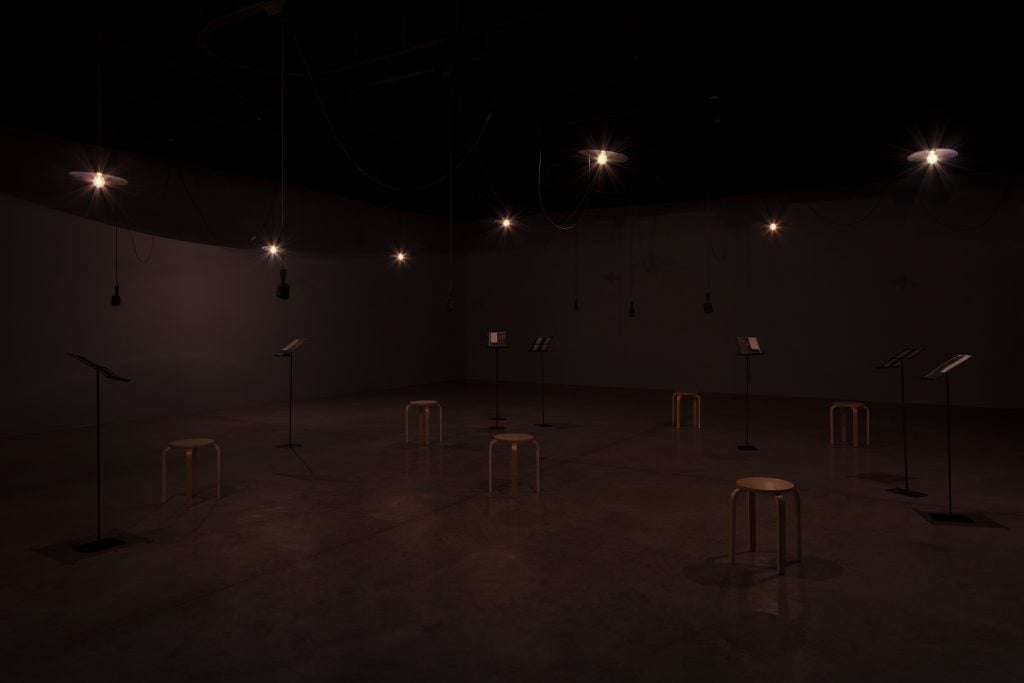
Shilpa Gupta, Listening Air (2022–23). Courtesy of the artist and Tanya Bonakdar Gallery, New York / Los Angeles.
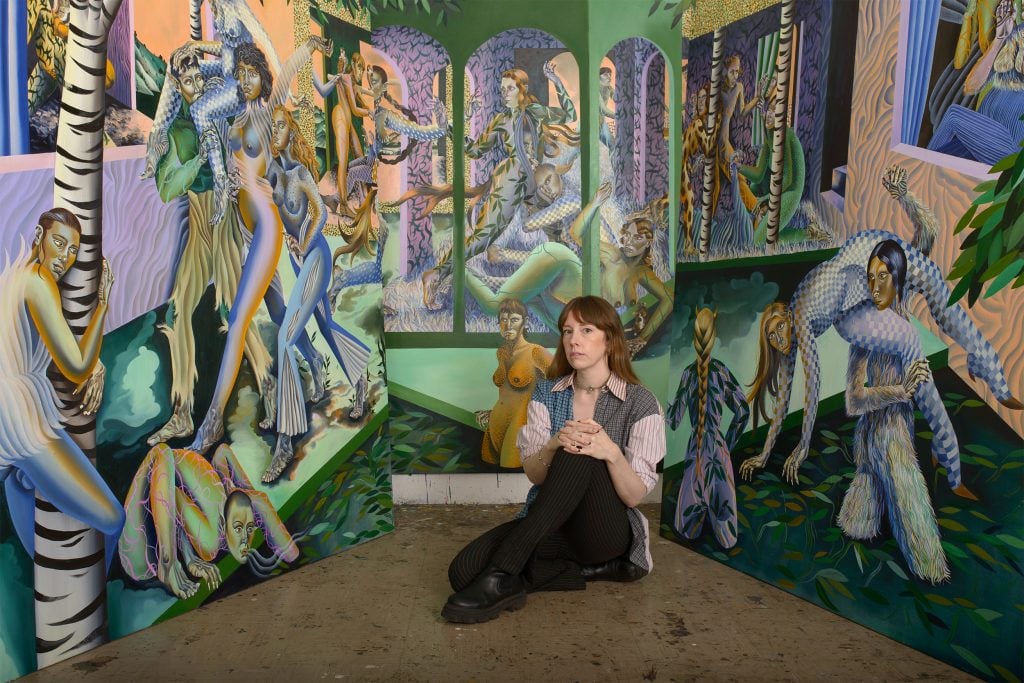
Jessie Makinson. Courtesy of Lyles and King, New York.
Marking a decisive moment in and evolution of the artist’s practice, Jessie Makinson created “Bad sleeper” at Lyles and King, an experimental, site-specific exhibition that melds her painting practice with the architecture of the gallery space, bringing it into the third dimension. Mining art history, literature, and cinema, Makinson presents viewers with a window into an otherworldly, fantastical realm filled with visual references and allusions to influential works by the likes of Italian writer Italo Calvino, Georgian filmmaker Sergei Parajanov, and Polish novelist Olga Tokarczuk. Narrative without being didactic, the scenes and vignettes portrayed elude easy reconciliation; almost human figures and alien-like landscapes beg questions but don’t offer easy answers, providing fertile ground for imaginative interpretations and conclusions.
The immersive project is made up of a hand-painted mural, patterned wallpaper, and plush purple carpet—together the antithesis of a sterile white cube—as well as paintings on canvas and a detailed wooden screen. Inverting common notions of how and where painting is displayed, “Bad sleeper” instead “makes a world for the paintings to live in.”
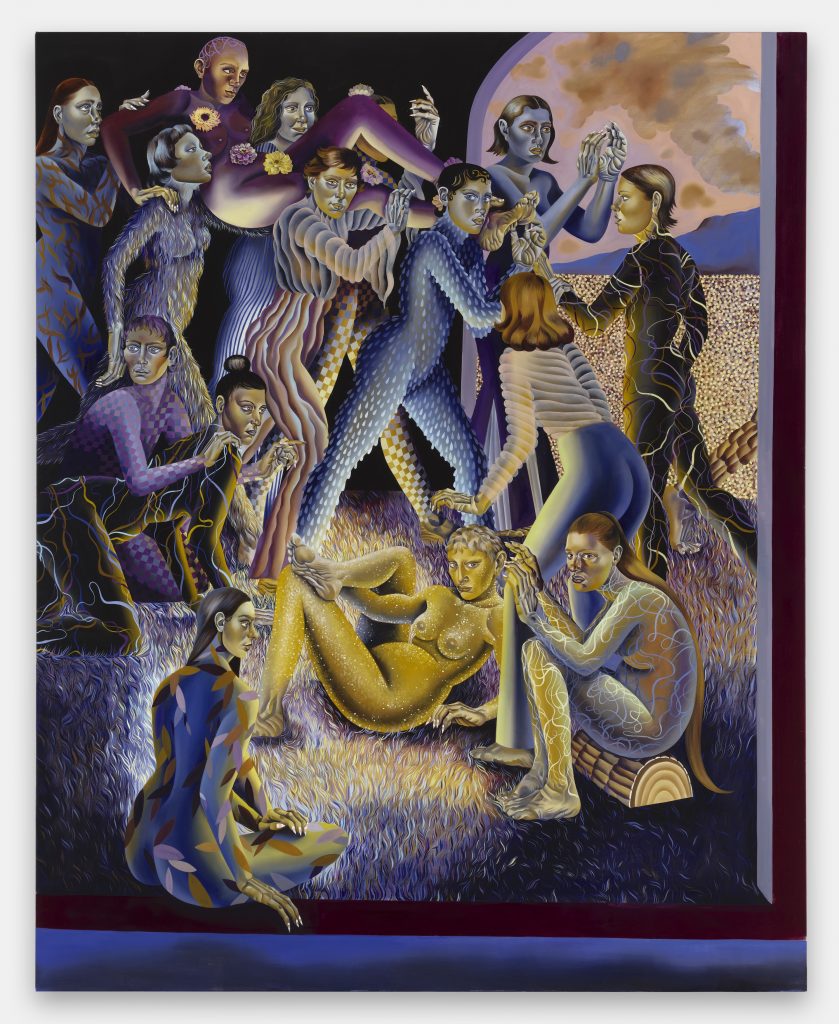
Jessie Makinson, Tiny Pyre (2023). Courtesy of Lyles and King, New York.
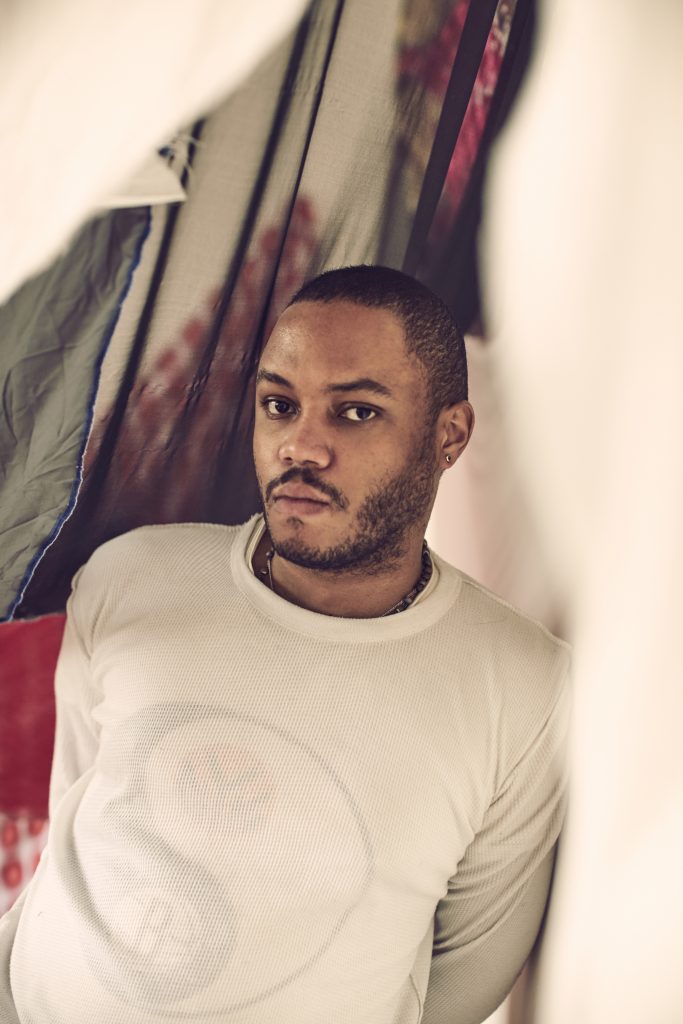
Eric N. Mack, 2021. © Eric N. Mack. Photo: Daniel King. Courtesy Paula Cooper Gallery, New York.
Working at the intersection of art, fashion, and architecture, Eric N. Mack creates intricate compositions comprised of fabric and found objects that defy easy categorization. A self-described painter working in the medium of fabric, each assembled work operates as an archive, recording not only the arrangements and juxtapositions of materials chosen by Mack, but the collection of fabrics themselves—whether it be fine silk, deadstock prints, or heavyweight suiting wools. How the materials interact with each other, as well as with the overall composition, and beyond the space the work occupies, invites considerations of the whole as well as the parts simultaneously. A hanging construction is the centerpiece of Mack’s eponymous exhibition, evoking Modern kinetic art and underscoring his ability to dialogue with surrounding architecture through carefully considered assemblages.
“Eric N. Mack” follows the announcement of his representation by Paul Cooper Gallery last year. In recent years, Mack has completed several high-profile residencies, including at the Chinati Foundation, Marfa, and the American Academy in Rome.
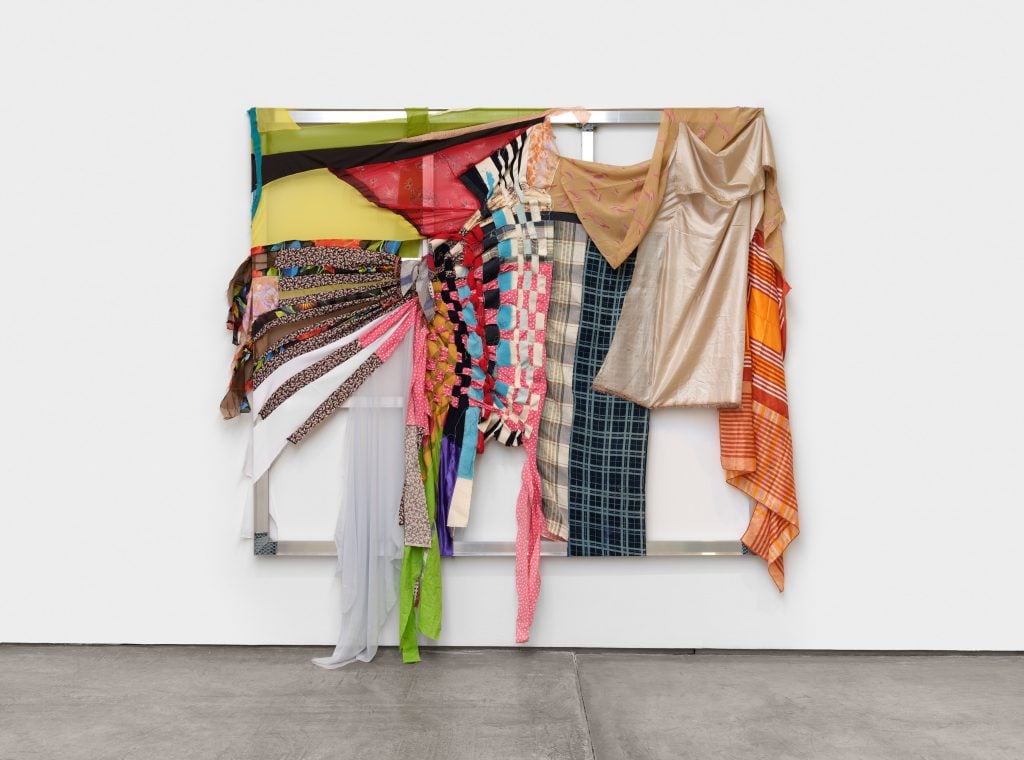
Installation view of “Eric N. Mack” (2023). Photo: Steven Probert. © 2023 Eric N. Mack. Courtesy Paula Cooper Gallery, New York.
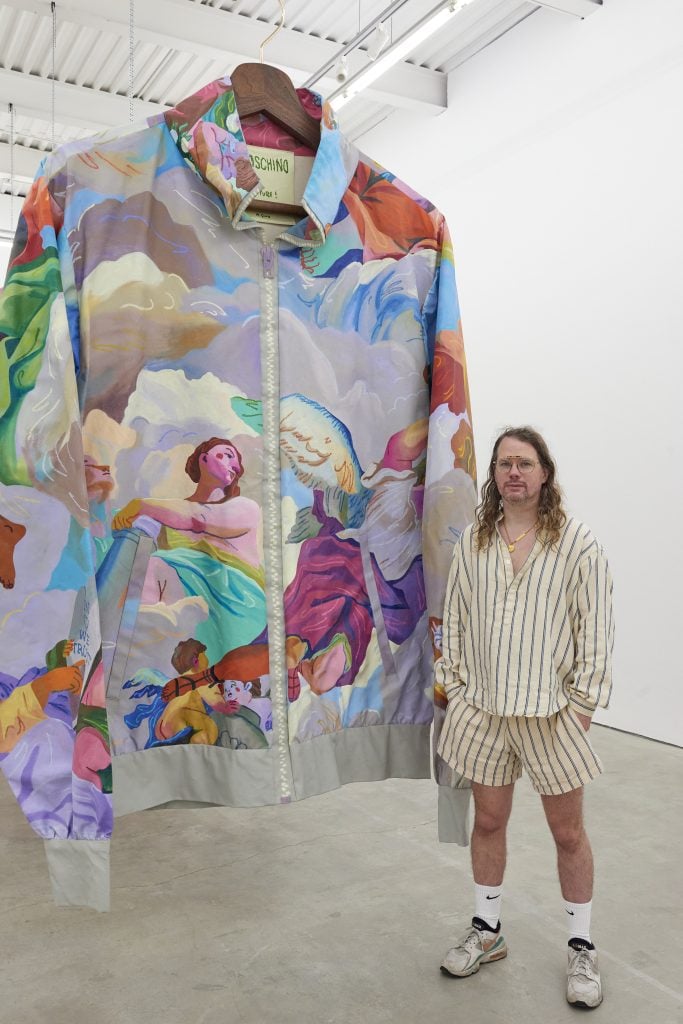
Andy Dixon. Courtesy of the artist and The Hole, New York / Los Angeles.
Artist and musician Andy Dixon started his career in Vancouver’s punk scene before pivoting to visual art, though his past endeavors continue to influence his practice. Using a process of appropriating old masterwork motifs and compositions—which Dixon compares to music sampling—these elements are then given the “Andy Dixon treatment,” transforming them by simplifying the forms and using a vibrant pastel palette that, together, evokes everything from Disney’s Fantasia (1940) to the oeuvre of Jean-Honoré Fragonard.
In his solo “Joy,” playfulness and joie de vivre abound. “The world could use a bit of happiness and celebration right now,” said Dixon. In Yolo 🙂 (2023) multicolor cherubs drawn from different paintings circle each other in the air, and in Yolo 🙁 (2023) a collection of skulls from various memento mori gaze haphazardly against what appears to be a Dutch landscape. Rounding out the exhibition is a collection of the artist’s outrageously oversized shirts, branded Hermes, Moschino, and Versace, offering a witty look into the sometimes dubious sometimes absurd relationship between retail, fine art, and luxury goods.
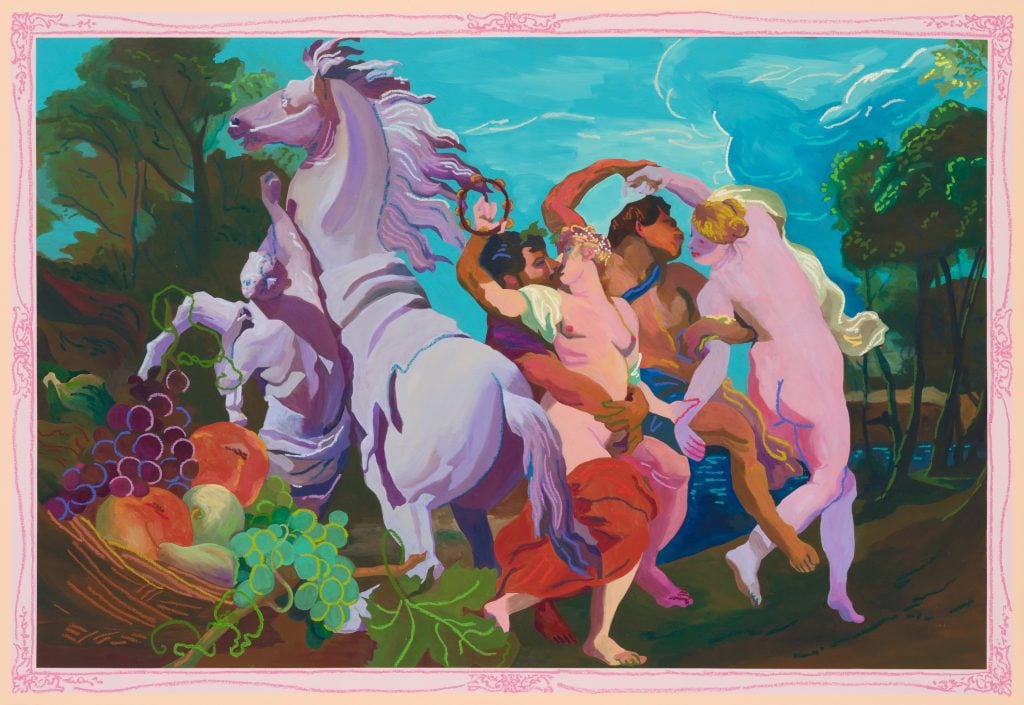
Andy Dixon, Pressed Pill (2023). Courtesy of the artist and The Hole, New York / Los Angeles.
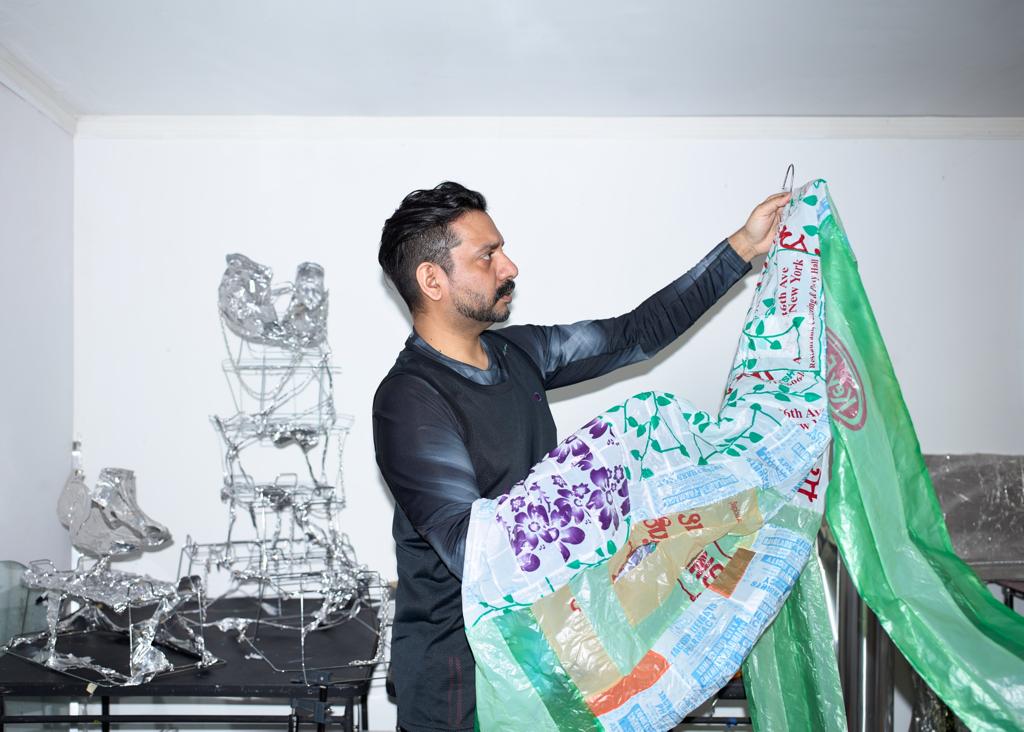
Asif Mian. Photo: William Jess Laird. Courtesy of Management, New York.
The recipient of the 2019–2020 Queens Museum-Jerome Foundation Emerging Artist Award, Asif Mian was the subject of a solo exhibition at the Queens Museum in 2021, which focused on the artist’s multi-part project RAF. Mian’s exhibition with Management, “The Village Bites Itself,” marks his first solo exhibition with a commercial gallery in the city, and sees Mian continue his exploration of how violence and the perception of violence affect both personal and collective memory, psychology, and behavior.
Mian’s multidisciplinary practice blends autobiographical and universal experience with the aim of responding to and reflecting on the theme of violence; deconstructing and reassembling elements of raw or readymade materials, such as aluminum sheeting or Afghan tribal rugs, the breaking down and rearranging of medium evokes a liminal psychological space, one detached from the quotidian where the “ghosts” of violent acts and the mental processing of violence reside.
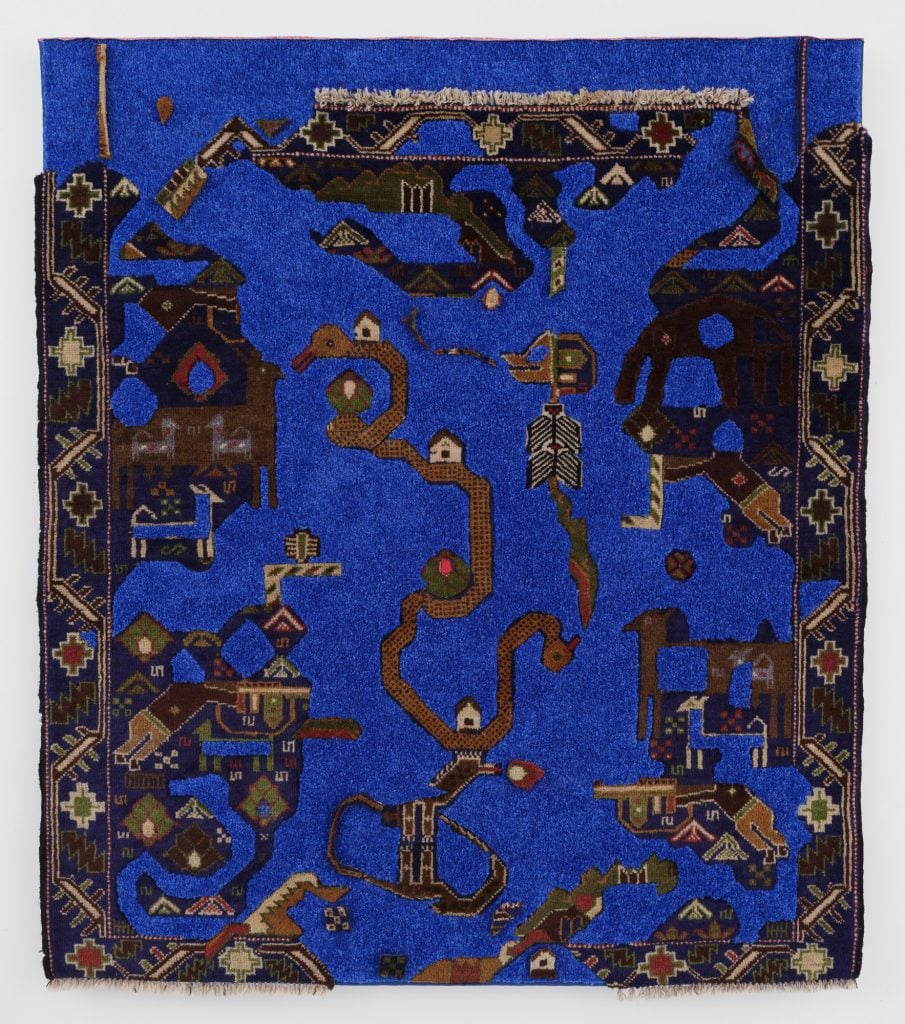
Asif Mian, The village bites itself, leaving a 6-foot scar from head to toe (2023). Courtesy of Management, New York.
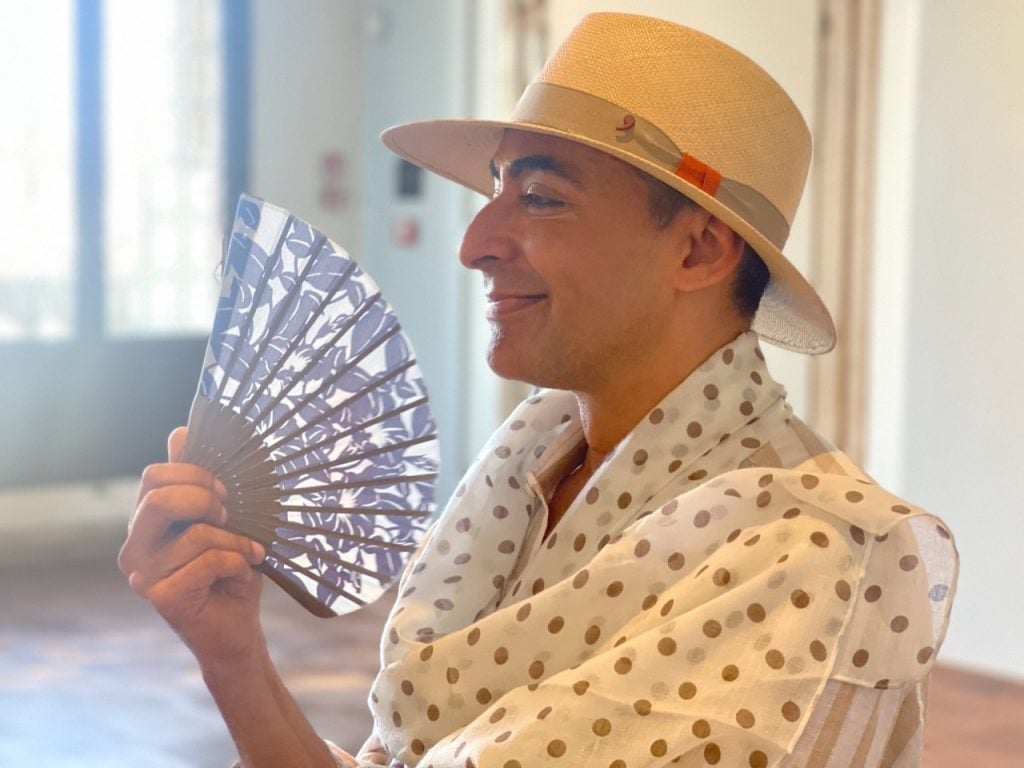
Raqib Shaw. Courtesy of Raqib Shaw Studio.
In his first presentation with Pace in New York since 2019, Raqib Shaw’s “Space Between Dreams” will see 16 works brought together. Shaw has garnered widespread recognition for his meticulous and intricate compositions that convey a diverse range of influences—from Japanese lacquerware and Persian carpets to early modern painting. Frequently conceived of as a series inspired by literature, art history, and mysticism, the works within the show synthesize real and imagined places and spaces, inspired by Shaw’s memories of Kashmir, where he is originally from, cityscapes and vignettes from his garden in London, where he is currently based, as well as vignettes reminiscent of New York, Paris, and Venice. Uniquely beguiling, each of Shaw’s works invites the mind’s eye to wander and explore.
Simultaneous to his showing with Pace, Shaw’s first traveling museum retrospective is on view at the Frist Art Museum in Nashville, “Ballads of East and West,” through December 21 before traveling to the Isabella Stewart Gardner Museum, Boston, in February 2024.
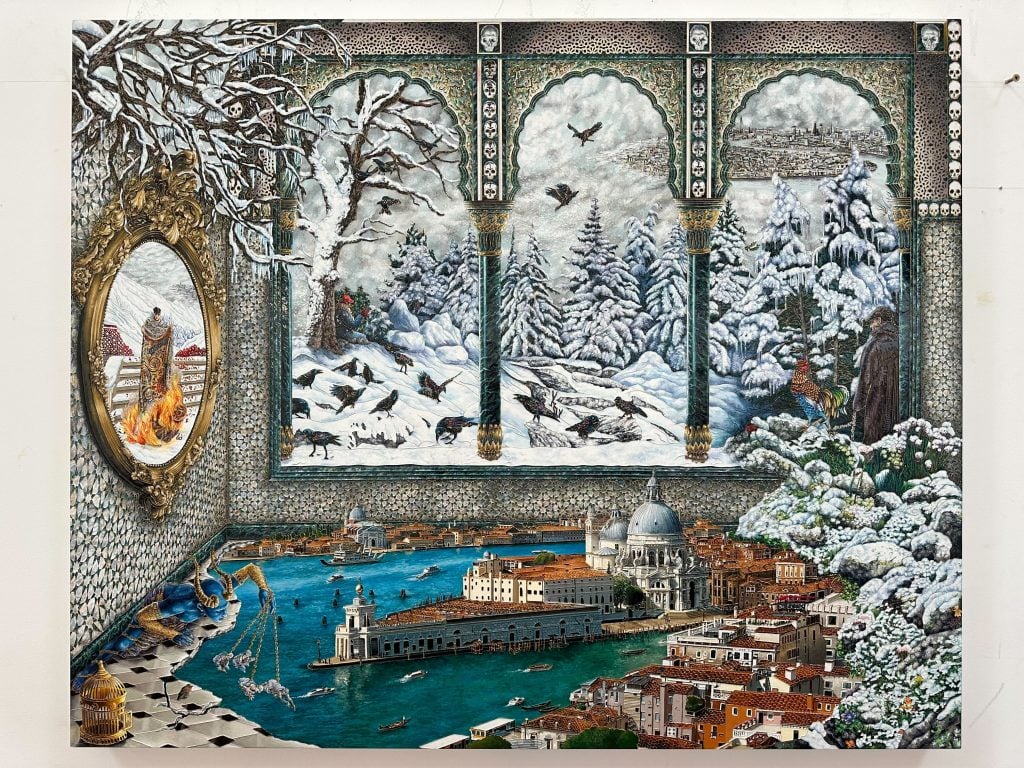
Raqib Shaw, Space Between Dreams – The Mourning Mendicant (2022–23). © Raqib Shaw / Artists Rights Society (ARS), New York. Courtesy of Pace Gallery.
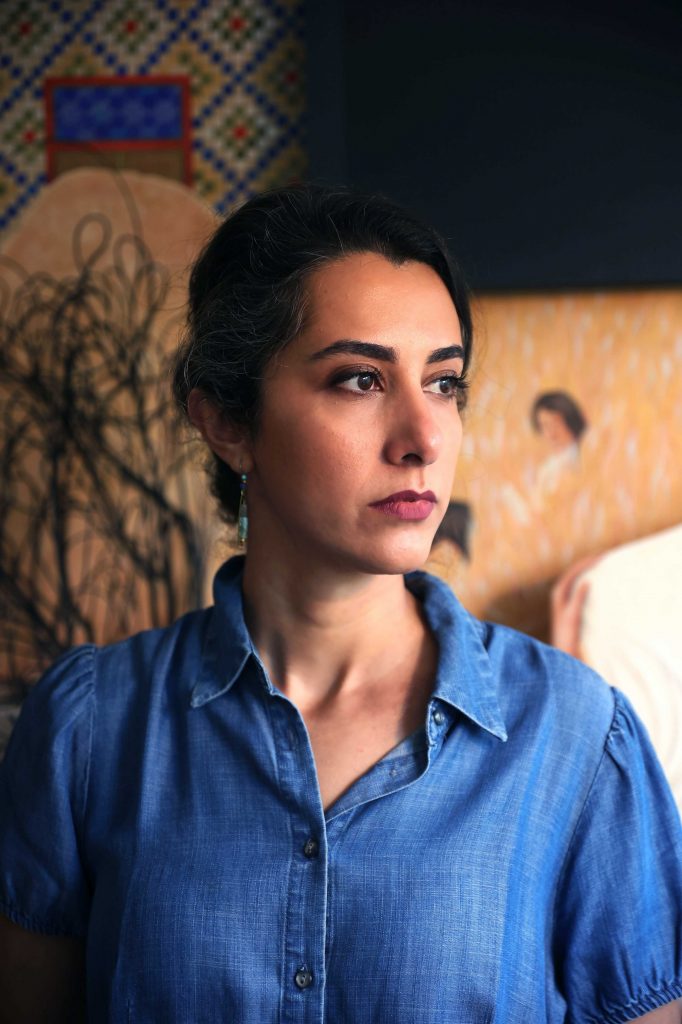
Arghavan Khosravi. Photo: Hossein Fatemi. Courtesy Rachel Uffner Gallery, New York.
Nine recent wall-mounted and freestanding sculptural paintings are included in Arghavan Khosravi’s second solo exhibition with Rachel Uffner, following on the heels of her solo exhibition at the Rose Art Museum, Waltham. “True to Self” illustrates Khosravi’s ongoing exploration of ideas and histories around identity, agency, and womanhood, and further provides insight into the evolution of her practice in light of Zan, Zendegi, Azadi (Woman, Life, Freedom), a global movement in solidarity with Iranian women and girls who peacefully demonstrate for their fundamental human rights.
Born in Iran in the years following the Islamic Revolution, Khosravi’s work shows the influence of the three decades she lived there, largely living dichotomously: following strict Islamic law in public while fostering freedom of thought and action in private. Themes of resilience, perseverance, and strength in the face of oppression are found throughout Khosravi’s oeuvre, as well as references to traditional architectural forms, Persian miniature paintings, and canonic artworks and stories ranging from tales of the Iranian hero Prince Siyavush to Bernini’s Rape of Proserpina. Commingling elements of sculpture with painting, Khosravi expresses the dynamism and complexity of lived experiences both conceptually and materially.
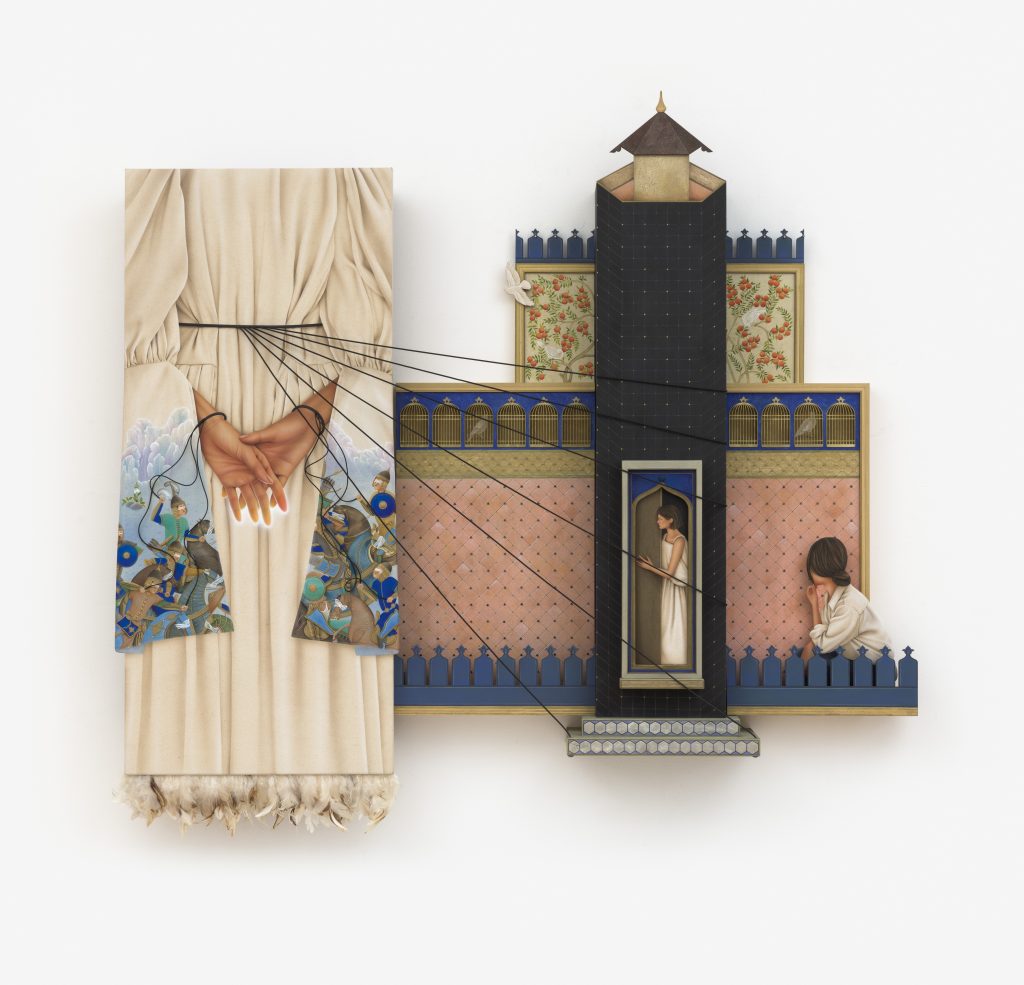
Arghavan Khosravi, The Battleground (2022). Courtesy of the artist and Rachel Uffner Gallery, New York.
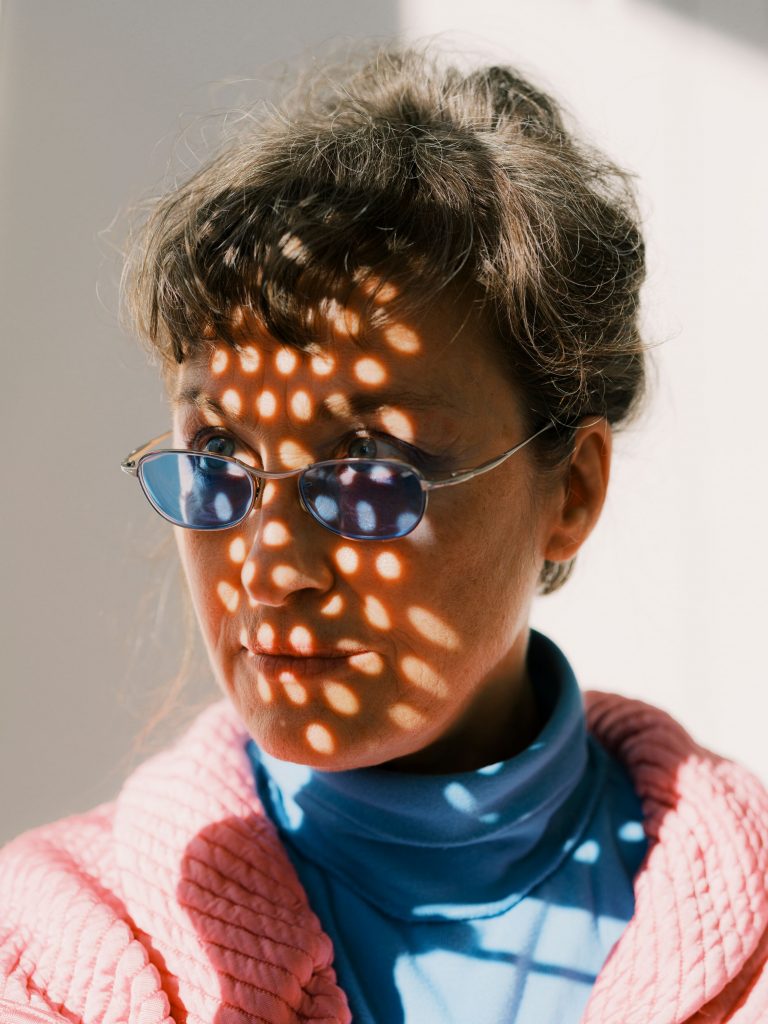
Pipilotti Rist (2022). Photo: Joël Hunn. Courtesy of the artist and Hauser and Wirth.
Swiss artist Pipilotti Rist is widely recognized for experimental video art and site-specific installations, as well as for maintaining a distinct surrealist bent in her work. This month, Rist is the subject of a major two-part exhibition staged between Hauser and Wirth’s West 22nd Street building and Luhring Augustine on West 24th Street. The complementary shows invite viewers on a multisensory journey through Rist’s imaginative and immersive world that spans both locations’ interior and exterior spaces, beginning with each of the gallery’s greeting visitors with an “artistic gesture” on their facades, Textile Simultaneity at Luhring Augustine and Innocent Collection at Hauser and Wirth.
Employing a wide range of media, including painting, video sculpture, projections, and more, each presentation will include works debuting for the first time, including new iterations of previous work such as occasion-specific videos that will be shown in the windows of Neighbors Without Fences (2020), a full-scale clapboard house facade. Playful and enchanting, across each presentation visitors will be enveloped in Rist’s singular artistic vision.
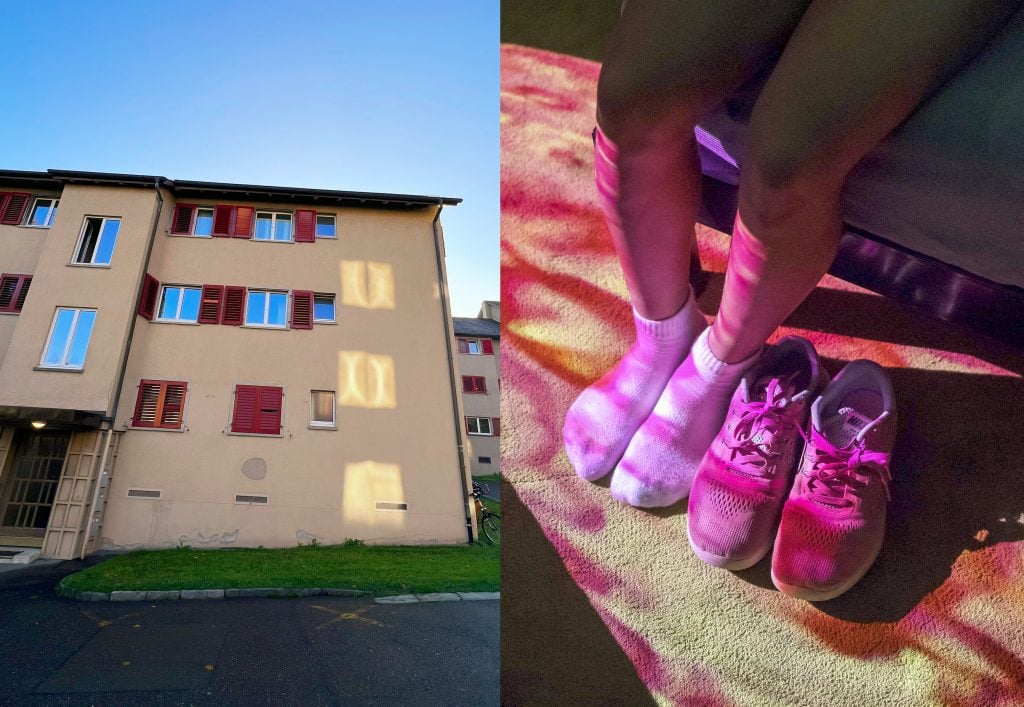
Pipilotti Rist, twin concept pictures (2023). © Pipilotti Rist. Courtesy of the artist, Hauser and Wirth and Luhring Augustine / Artists Rights Society (ARS), New York.